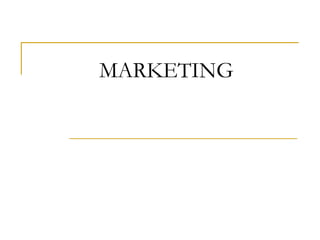
Chapter 1. marketing
- 1. MARKETING
- 2. What is Marketing? It is the process of planning and executing the conception, pricing, promotion and distribution of ideas, goods and services to create exchanges that satisfy individual and organizational goals.
- 3. How Does Selling Differ from Marketing? Marketing is a pre-development function Marketing looks for unmet needs and customer preferences Marketing is increasingly becoming a strategic function which handles company brand as well as product brands Marketing now has well-established theories and best practices
- 4. NEEDS, WANTS AND DEMAND A need refers to something which is deep rooted in an individual's personality. State of felt deprivation example: Need food Wants are the culturally influenced manifestation of a deep- seated need. The form of needs as shaped by culture and the individual example: Want a Big burger Demand is the willingness and ability of buyers to purchase a product that satisfies their need. Wants which are backed by buying power.
- 5. Exchange The provision or transfer of goods, services, or ideas in return for something of value
- 6. Concepts in Marketing Production concept holds that consumers will prefer products that are widely available and inexpensive. Managers of production oriented businesses concentrate on achieving high production efficiency, low costs and mass distribution. They assume that consumers are primarily interested in product availability and low prices. Product Concept consumers favor those products that offer the most quality, performance or innovative features. Managers in these organizations focus on making superior products and improving them over time. They assume that buyers admire well made products and can evaluate quality and performance.
- 7. Selling Concept The organizations undertake an aggressive selling and promotion effort. The aim is to sell what they make rather than make what the market wants. Marketing Concept Holds that the key to achieving its organizational goals consists of the company being more effective than competitors in creating, delivering and communicating superior customer value to its chosen target markets. The marketing concept rests on four pillars: target market, customer needs, integrating marketing and profitability.
- 8. Societal Marketing Concept holds that a company should make good marketing decisions by considering consumers' wants, the company's requirements, and society's long-term interests. It is closely linked with the principles of corporate social responsibility. Relationship Marketing Building long term mutually satisfying relations with customers, suppliers, distributors in order to retain their long term preference and business.
- 9. Customer Relationship Management (CRM) Using information about customers to create marketing strategies that develop and sustain desirable customer relationships Identifying buying-behavior patterns of customers Using behavioral information to focus on the most profitable customers
- 10. The Marketing Mix Four marketing activities—product, distribution, promotion, and pricing—that a firm can control to meet the needs of customers within its target market ProductProduct DistributionDistribution PromotionPromotion PricingPricing TargetTarget MarketMarket
- 11. 4 P’s: Product, Price, Place, Promotion Product: Features, benefits, value offered Price: Base price, discount, bundling Place: Direct, retail, mail order, Internet Promotion: Advertisements, promotional events 4 C’s – Customer solution, Cost, Convenience, Communication
- 12. The Nestle Way The “Nestlé way” is to dominate its markets can be summarized in four points: (1) think and plan long term (2) decentralize (3) stick to what you know, and (4) adapt to local tastes • Nestlé sells more than 8,500 products produced in 489 factories in 193 countries • Nestlé sells more than 8,500 products produced in 489 factories in 193 countries • Nestlé is the world’s biggest marketer of infant formula, powdered milk, instant coffee, chocolate, soups, and mineral water • Nestlé is the world’s biggest marketer of infant formula, powdered milk, instant coffee, chocolate, soups, and mineral water
- 13. A classification of decisions made by marketers Product Price Place Promotion People Processes Physical evidence
- 14. RELATIONSHIP MARKETING &TRANSACTIONAL MARKETING COMPARED
- 15. COMPONENTS OF MARKETING ORIENTATION 3 components: customer orientation competitor orientation inter-functional co- ordination
